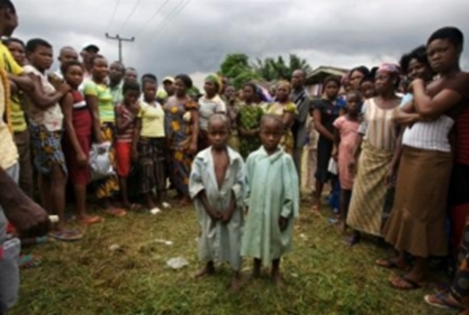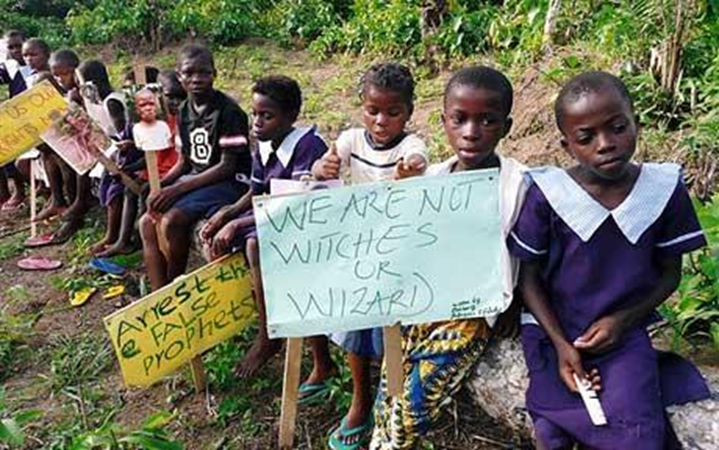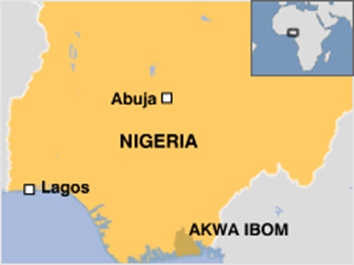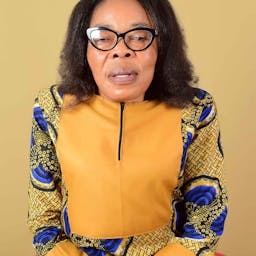Child-witch Branding in NIigeria
Jan 21, 2015
Story



In the Akwa Ibom State of Nigeria, child-witch branding is a phenomenon ravaging the lives of many children. Parents, guardians and communities are misled into battering, maiming, drowning, burning and abandoning children accused of witchcraft. All this at the hands of church leaders who initiate the accusations of young children and instigate their abuse by heightening people’s belief in witches. Further, they are guilty of carrying out abusive activities believed to dispossess accused children of their witchcraft spirits.
A deep-seated fear of witchcraft cuts across Africa. Among the Efik and Ibibio peoples of the Akwa Ibom state of Nigeria, witchcraft is a common phenomenon believed among the people as the art of bringing magical powers to manifest that which one desires. The powers are often perceived as malevolent and given by spiritual entities. It is commonly accepted that a spiritual spell can be given to a person through food or drink, driving the soul of the person who eats the spiritual spell to leave the body and become initiated in a clan of other witches and wizards. This newly recruited person is presumed to have been given the powers to wreak havoc in the community. More specifically, witches can be bestowed with the power to cause hardship in the lives of other people, including causing death through inflicting diseases like malaria, cancer, HIV/AIDS, hepatitis, typhoid fever, cholera, and tuberculosis. Indeed, it is generally believed that all the evils which befall human beings are caused by the malevolent activities of witches.
The Irony of a High Level of Poverty in an Oil-Rich Area
Akwa Ibom is a state located in Nigeria’s oil rich delta region, yet the wealth accrued from abundant oil resources does not touch the lives of the local citizens. In fact, there are high levels of poverty affecting the lives of the people. Nigeria’s The Daily Trust reported that the Niger Delta accounts for 35% of the poverty rate in Nigeria. In the face of abject poverty and economic hardship confronting more than 85% of Nigerians living in the midst of abundant resources, people are eager to make meaning of their misfortune. As Sam Itauma, the Director of Child Rights and Rehabilitation Network explains, “if you are not rich and don't have anything to eat, you look to blame someone.”
In addition to problems related to poverty, in Akwa Ibom, the business activities of oil firms have subjected the state to large scale air, land and sea contamination, which in turn, is capable of causing all manner of sicknesses. The people are grossly ignorant of the negative effects of this widespread contamination on their health, and instead, are inclined to link the daily sicknesses, hardship and poverty bedeviling them to other forces.
The Role of Religion
The natural human tendency to want an explanation for one’s own hardship, coupled with the belief in the existence of powers, spirits, and evil forces, implicates religion in this region in Nigeria. Aside from strongly adhering to traditional religion, which supports a deep-rooted belief in the existence and activities of spiritual forces, the people have historically embraced the religious beliefs of early Christian missionaries to Nigeria.
Now predominantly Christians, the people of Akwa Ibom state make up a large share-- 45%--of the country’s total number of Christians. With the increase in economic hardship, sicknesses, and growing ills in the local society, this percentage represents a significant growth in Christianity, especially in the past five decades. Many churches have been newly established, as a result, though most are dominated by spiritualists who promote deep-rooted belief in traditions, customs and practices, alongside belief in more typical tenets of Christian religion. Ignorance and superstition reinforce traditional beliefs that spirits are real and intervene in human affairs. The effect is that people uphold strong beliefs in the existence of God, Jesus Christ, sin and Satan, but also demonic possession, heaven and hellfire, and witchcraft.
Reinforced by a growing number of community hardships, churches have also become solution grounds for people’s multiple problems. It has become a common practice for church leaders to exploit their congregants’ ignorance. A primary way this is done is to satisfy the need for an explanation by branding people witches. The Vanguard quoted a bishop, Sunday Ulup-Aya, saying that, “among Akwa Ibomites, 2.3 million people morph nightly into birds of terror leaving their victims barren, unemployed, deaf, dumb, pauperized, ill, maimed and disorientated.”
Prior to 1998, it was practice, but not too common, to accuse elderly women of being witches responsible for the calamities befalling people. These women were frequently lynched on the streets for the alleged crimes. More recently, it is believed that children are more susceptible to witches’ spells, hence children are believed to be the sought-after targets for initiation by elderly witches. This development heightens fears of witchcraft, leading to an increase in accusations of children as witches. Religious ‘prophets’ sensationally allude to “those of them whose teeth are like graders, enjoying a nightly feast on human kidneys, heart and flesh,” forcing select children between the ages of 2 and 15 to bear the brunt of this ancient superstitious belief. Mr. Ituama, the founder of the Child Rights and Rehabilitation Network (CRARN) emphatically estimates that from 1998 till 2008, on a daily basis, up to five or more children are branded as witches.
Religious profiteering
Some Nigerians see the establishment of churches as a lucrative business, where pastors grow richer and the worshipers grow poorer. In the case of child-witches, this point is convincingly made through the church leaders’ call for deliverance and dispossession of accused children. Parents and congregants are made to pay exorbitant fees for the violent ‘treatments’ by church leaders against so-called child-witches in the name of ‘deliverance.’ A prophet in a church in Ibaka was said to pour a homemade substance—called African mercury, a portion of pure alcohol and blood—into the eyes of a young boy, saying, "I want this poison to destroy the witch right now, in Jesus' name." A woman, Utitofong, was reported to have spent four months' salary on an unsuccessful exorcism of her two baby-girls. Parents are given the option to pay in instalments or perhaps sell their property. Consequently, the more children the pastor declares as witches, the more famous he gets and the more money he can make.
Reverend Helen Ukpabio, a Nigeria’s wealthy evangelist is accused of leading a resurgence of witch-hunting on a massive scale, especially on children in the Akwa Ibom state. She is accused of creating a cloud of witchcraft fear through her film, End of the Wicked, which tells in graphic detail how children become possessed. Worst of all, the film uses child-actors to depict scenes of children being inducted into covens, eating human flesh, and bring about destruction in families. In the Unveiling the Mysteries of Witchcraft, the most controversial of Helen’s written books, she teaches how to identify a witch, saying that the major signs manifesting a “servant of Satan, for children under two years, are crying and screaming in the night, high fever and worsening health conditions.” Thanks to a record of poor health care. These are symptoms that can be found among many children in impoverished regions like the Nigeria’s Niger Delta.
The intervention of NGOs
CRARN, a non-governmental organization formed to rescue children accused of witchcraft in the Akwa Ibom state, was joined in alliance with Stepping Stones Nigeria Child Empowerment Foundation (SSNCEF), a child rights organization established in 2008 in response to the trend of child abandonment arising from the practise of child-witch accusations. With the intervention of these organizations, child-witch issues have become of great concern to Nigerians at home and around the world. While first-hand stories are hard to come by due to protections provided for children by the NGOs that support them and the government, the UK's The Observer published a piece in 2007 that shed light on some of the heart-wrenching stories of affected children; CNN carried similar news in 2010:
Gerry was eight years old when he was picked out at a prayer night and named a witch. His father siphoned petrol from his motorcycle tank and spat the petrol over Gerry’s face, blistering his face severely. Mr Umoh, the Program Officer of CRARN said that before Gerry left the Rehabilitation center, he asked every adult he saw if they would take him home to his parents: 'It's not them, it's the prophetess, I am scared of her.'
Mary was 7 years old when she was brought to the center. It was said that when Mary’s youngest brother died, the pastor of her church told Mary’s mother that the younger brother succumbed because Mary was a witch. “Three men came to my house. I didn't know these men. My mother left the house. She left these men. They beat me.” She pushes her fists under her chin to show how her father lay, stretched out on his stomach on the floor of their hut, watching. After the beating, there was a trip to the church for a ‘deliverance'. The next day she was taken for a walk in the bush with her mother. The men picked poisonous 'asiri' berries that were made into a draught and forced down her throat. Mary’s mother warned Mary that if the berries did not kill her, then she would be hanged with a barbed-wire. Finally her mother threw boiling water mixed with caustic soda over Mary’s head and body before her father abandoned her in a field. Drifting in and out of consciousness, she stayed near the house for a long time before finally slinking off into the bush. Mary was seven. She says she still doesn't feel safe. She says: 'My mother doesn't love me.' And, finally, a tear streaks down her beautiful face.
Prince and Rita were also kept in the home. Rita told her mother she had a dream where there was lots to eat and drink at a party. The belief is that a witch flies away to the coven at night while the body sleeps. Thus Rita's sweet dream was proof enough that she was a witch and because she had shared food with her brother, the way witchcraft is spread, both were abandoned by their parents and were picked up by CRARN.
Marose was seven when her mother dug a pit in the woods and tried to bury her alive, whereas Michael was found by a farmer clearing a ditch. Michael was said to be starved and unable to stand on his thoroughly flogged legs. He was accused of being responsible for the death of his mother.
When Mary was rescued by Gary Foxcroft, the Programme Director of Stepping Stones Nigeria in 2008, she was five years old. By then the CRARN refugee home for witch-branded children already had 150 other residents, all of whom had been blamed for their family's woes and abandoned. Mr. Umoh of CRARN estimates that more than 5,000 children have been branded in the Akwa Ibom area of Nigeria since 1998. “Many bodies of innocent children were dumped in the rivers or in the forest and many were not found.” A report made available by Mr. Edjo, Advocacy Officer of SSNCEF, reveals the following: 105 cases resulted in serious injury on the children; 233 cases resulted in abandonment; 28 cases in which accused children were missing; and five cases resulted to death.
Anthony Ebuk, a human rights lawyer, confirms that many children who were branded child-witches have been murdered, hacked to death with machetes, drowned, or buried alive in attempts to ‘drive Satan’ out of them. He sees these as calculated actions by church leaders, parents, and communities to get rid of them. He says, “it is a herculean task to attempt to rescue these children. Parents sometimes claim ‘this is my child’ and therefore feel the freedom to do anything they like with him or her.” He also shares that in churches, children are tortured. Ostracising children from the community is very common: some children are found wandering in the nearby Abia State. Comrade Nelson of Foundation for Environmental Rights, Advocacy and Development in Abia State, said that more than 50 children of Akwa Ibom state origin have been seen walking aimlessly on the streets of Aba in Abia state.
It is left unanswered why exactly the witch-branding is usually targeted at children of 15 years downwards. Mrs. Imeh, a banker in Lagos and an indigene of Akwa Ibom, says that many families are disintegrating, and the futures of children-- our future leaders-- are being shattered by the phenomenon of child-witch stigmatization.
Government intervention
The attention of the government was drawn to this issue by an accusatory documentary by Mr. Foxcroft of SSNCEF, entitled Saving Africa’s Witch Children. The documentary put the government of Akwa Ibom state on the spot for the crimes against its children, prompting the state to sign into law the Child Rights Act in December 2008. The Child Rights Act protects children younger than 16 years old and ascertains their right to enjoy physical, social and psychological well-being. It also strengthens the mechanisms for the defense and protection of children, as well as criminalizes child abuse. Despite its seemingly thorough terms, Barrister Ebuk reports that implementation of the act is often faulty as judges have thus far failed to prosecute offenders. He says that some attorneys do not even know of the law’s existence in the state.
The Governor of the state, Godswill Akpabio went further to establish a six-person Witchcraft Commission of Inquiry in May 2011. The Commission is mandated to make recommendations on the incidence of witchcraft and child abuse in the state. A government official confirmed for the writing of this piece that the commission is actively investigating cases of child abuse related to witch-branding.
CRARN sees the intervention by government as a relief. Mr. Umoh says that since the inception of the Child Rights Act and establishment of the Commission, child-witch branding cases have decreased in the state. A report made available by CRARN indicates that more than 170 children have been successfully reunited with their parents. Nine children are still at the CRARN center, about 185 children were relocated to the government’s Special Children’s Center, and a good number are cared for at the Divine Children’s Center, an institution also established by the government in conjunction with a private organization. For the children who are still living at the centers, hope still exists that they can be reunited with their parents soon.
To fully eliminate the phenomenon of child-witch accusation and stigmatization in Nigeria, NGOs need to invest in intensified efforts to raise awareness of the issue among the people. The law enforcement agencies must prosecute the religious prophets who derive affluence and wealth from branding innocent children as witches, causing families and communities to all but disintegrate. Unveiling the Mysteries of Witchcraft, and End of the Wicked, two materials
portraying children in the devastating light of a witchcraft accusation, should be proscribed.
This article is part of a writing assignment for Voices of Our Future a program of World Pulse that provides rigorous new media and citizen journalism training for grassroots women leaders. World Pulse lifts and unites the voices of women from some of the most unheard regions of the world.




